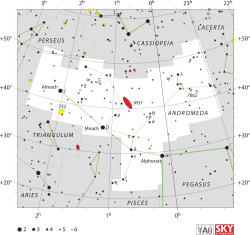Chi Andromedae

| |
| Observation data Epoch J2000.0 Equinox J2000.0 | |
|---|---|
| Constellation | Andromeda |
| Right ascension | 01h 39m 21.0s[1] |
| Declination | +44° 23′ 10″[1] |
| Apparent magnitude (V) | +5.1627[1] |
| Characteristics | |
| Spectral type | G8 III |
| U−B color index | +0.55[2] |
| B−V color index | +0.883[1] |
| Astrometry | |
| Radial velocity (Rv) | +6.54[3] km/s |
| Proper motion (μ) | RA: –19.78[1] mas/yr Dec.: +15.40[1] mas/yr |
| Parallax (π) | 13.03 ± 0.55[1] mas |
| Distance | 250 ± 10 ly (77 ± 3 pc) |
| Orbit[4] | |
| Period (P) | 21.5 ± 0.1 yr |
| Eccentricity (e) | 0.368 ± 0.020 |
| Periastron epoch (T) | 43,216 ± 60 MJD |
| Argument of periastron (ω) (secondary) | 144 ± 3° |
| Semi-amplitude (K1) (primary) | 3.01 ± 0.09 km/s |
| Details | |
| Radius | 9[3] R☉ |
| Luminosity | 47[3] L☉ |
| Surface gravity (log g) | 2.9[3] cgs |
| Temperature | 5,070[3] K |
| Metallicity [Fe/H] | –0.21[3] dex |
| Rotational velocity (v sin i) | 0.0[3] km/s |
| Other designations | |
Chi Andromedae (χ Andromedae, χ And) is the Bayer designation for a star in the northern constellation of Andromeda. It has an apparent visual magnitude of +5.2,[1] which is relatively faint for a naked-eye star. Based upon parallax measurements made during the Hipparcos mission, Chi Andromedae is located around 250 light-years (77 parsecs) from Earth.[1]
It with φ And composed the Chinese asterism 軍南門 (Keun Nan Mun, Mandarin jūnnánmén), "the South Gate of the Camp".[6] χ Andromedae is a member of 天大將軍 (Tiān Dà Jiāng Jūn), meaning Heaven's Great General, together with γ Andromedae, φ Persei, 51 Andromedae, 49 Andromedae, θ Andromedae, τ Andromedae, 56 Andromedae, β Trianguli, γ Trianguli and δ Trianguli. Consequently, χ Andromedae itself is known as 天大將軍五 (Tiān Dà Jiāng Jūn wu, English: the Fifth Star of Heaven's Great General.)[7]
This is most likely a spectroscopic binary system with an estimated orbital period of 21.5 years and an eccentricity of 0.37. The primary component has a stellar classification of G8 III,[4] which indicates it is a giant star that has exhausted the supply of hydrogen at its core and evolved away from the main sequence. The outer envelope has expanded to about nine times the radius of the Sun and it is radiating 47[3] times the luminosity of the Sun at an effective temperature of 5,070 K.[3] This heat gives the star the yellow-hued glow of a G-type star.[8] It appears to be rotating very slowly with no measurable projected rotational velocity.[3]
References
- 1 2 3 4 5 6 7 8 9 van Leeuwen, F. (November 2007), "Validation of the new Hipparcos reduction", Astronomy and Astrophysics, 474 (2): 653–664, arXiv:0708.1752
 , Bibcode:2007A&A...474..653V, doi:10.1051/0004-6361:20078357.
, Bibcode:2007A&A...474..653V, doi:10.1051/0004-6361:20078357. - ↑ Argue, A. N. (1966), "UBV photometry of 550 F, G and K type stars", Monthly Notices of the Royal Astronomical Society, 133: 475–493, Bibcode:1966MNRAS.133..475A, doi:10.1093/mnras/133.4.475.
- 1 2 3 4 5 6 7 8 9 10 Massarotti, Alessandro; et al. (January 2008), "Rotational and Radial Velocities for a Sample of 761 HIPPARCOS Giants and the Role of Binarity", The Astronomical Journal, 135 (1): 209–231, Bibcode:2008AJ....135..209M, doi:10.1088/0004-6256/135/1/209.
- 1 2 Griffin, R. F. (June 1998), "Spectroscopic binary orbits from photoelectric radial velocities. Paper 140: Chi Andromedae", The Observatory, 118: 158–165, Bibcode:1998Obs...118..158G.
- ↑ "chi And -- Star", SIMBAD Astronomical Object Database, Centre de Données astronomiques de Strasbourg, retrieved 2012-06-25.
- ↑ Allen, R. H. (1899), Star-names and Their Meanings, New York: G. E. Stechart, p. 39.
- ↑ (Chinese) AEEA (Activities of Exhibition and Education in Astronomy) 天文教育資訊網 2006 年 7 月 10 日
- ↑ "The Colour of Stars", Australia Telescope, Outreach and Education, Commonwealth Scientific and Industrial Research Organisation, December 21, 2004, archived from the original on 2012-03-10, retrieved 2012-01-16.